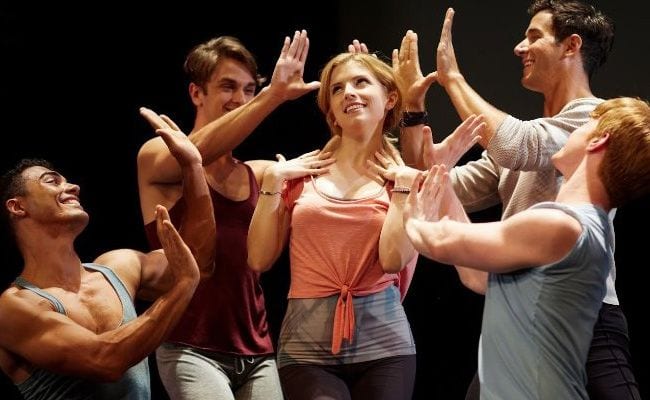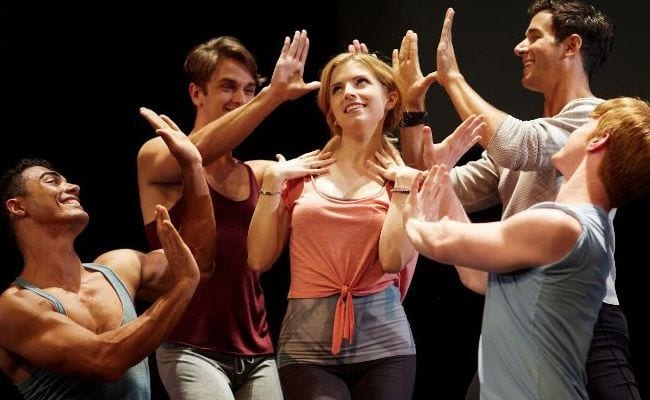
“Jamie is over, and Jamie is gone,” Cathy (Anna Kendrick) sings as The Last Five Years opens. She sits in front of a desk, on which rests a parting letter that her now ex-husband Jamie (Jeremy Jordan) left for her. Her apartment is grey. A tear runs down her cheek.
This is a ripe dramatic moment, one that Kendrick sells beautifully with her rendition of the lament “Still Hurting”. In the chronology of The Last Five Years, however, this powerful beginning is not the beginning at all, but rather the end.
The Last Five Years, originally written as a musical for two voices by Jason Robert Brown and directed in this film adaptation by Richard LaGravenese, tells the tale of Cathy and Jamie’s dissolution from two perspectives: hers, which unfolds backwards in time; and his, which begins from the start of the relationship. Only once do they meet in the middle.
Right away, this structure makes something evident about Cathy and Jamie’s marriage: they are rarely, if ever, on the same track. This bears itself out most obviously in their career paths. When he and Cathy commence their relationship, Jamie is already a rising literary talent; by the time these five years are at their last moments, he’s a national literary star — he is called a “young Jonathan Franzen” by his literary agent.
Cathy’s career, in contrast, is marked by constant uphill battles (as she puts it in the tune “Climbing Uphill”). Despite constant auditions and an obvious well of talent, she can’t land a gig anywhere she goes, ultimately resorting to working at a community theatre in Ohio. On their own, Cathy’s struggles are a heavy weight for her to carry; it doesn’t help that the increasingly successful Jamie spends much of his time at parties and book signings refining his literary playboy personality.
This conflict of careers is but one of many that leads to the divorce letter Cathy reads at the beginning of The Last Five Years. Their divergent levels of success form the linchpin case that the forward/reverse narrative structure illustrates quite plainly: despite the love and chemistry present in their relationship, they aren’t truly unified. One is caught in regress out of her control, the other in progress that he gets all too happily drunk on.
This narrative conceit of The Last Five Years, one of the many factors that has made it a cult classic of a musical in the past decade, also comes with a cost. Because it’s known right from the start that Cathy and Jamie don’t work, a certain amount of narrative tension is drained out of the story. Instead of explaining the “what” and “why” of a couple’s disunion, The Last Five Years focuses exclusively on the latter. Indeed, because of its unique structure, the film sheds a great deal of light on the “why” of Cathy and Jamie’s divorce; unfortunately, it become monotone in the telling rather quickly.
As the tension between Jamie’s literary breakthrough and Cathy’s difficulty in finding a Broadway gig gets stretched across the length of The Last Five Years, its point gets hammered home repeatedly. This is in large part due to the microscopic focus of the story: save for some background players with scattered lines, the focus of the musical is entirely on Cathy and Jamie. Their world is the only one the audience is given any access to. (This effect is undoubtedly more intensely felt in the theatre productions of the musical, as it’s usually staged with no secondary players whatsoever.)
Because it’s known from the get-go that the two do not end up together, Jamie’s scenes necessarily have an ominous undertone to them (captured quite strikingly in the number “Nobody Needs to Know”, with rich grey colors in the background). Likewise, Cathy’s reminiscence of what her marriage had once been is draped in a melancholy nostalgia. Cinematographer Steven Meizler is quite aware of this juxtaposition, and as such he chose to shoot much of Jamie’s scenes in a warm, slightly incandescent light so as to capture the optimism of a young love blossoming; Cathy’s scenes play out to less inviting light schemes.
Suffice it to say: by the time Jamie arrives at the end of these Last Five Years, and Cathy has arrived back to where she and Jamie started, the reasons why have been obvious for some time. In less competent hands, this predictability would have resulted in an inoffensive movie whose one benefit is an interesting plot structure. Fortunately, LaGravenese has Kendrick and Jordan as his leads, and neither of them phone these roles in.
Kendrick gets the most emotionally resonant tunes in Brown’s book, such as the aforementioned “Still Hurting”, the tragicomic “A Part of That”, and the dramatic irony-drenched “I Can Do Better Than That”. Because Jamie is a far less sympathetic character than Cathy, Jordan has to do a good amount of work to be appealing, and he does not disappoint. From the over-the-top klezmer delight that is “The Schmuel Song” to the anger-charged “If I Didn’t Believe In You”, he gives Jamie a great deal of character development, in addition to the already solid material in Brown’s original musical.
On the chemistry front, too, Kendrick and Jordan impress: the centerpiece of the musical, “The Next Ten Minutes”, finds them connecting in a tender romantic moment, one that results in the ultimately doomed wedding proposal. It may be difficult to take in “The Next Ten Minutes” for all its beauty knowing that Cathy and Jaime’s relationship has an expiry date, but Kendrick and Jordan deliver the scene in such a way that, even if only fleetingly, you believe they’re in love.
The only extras included on the Blu-ray release are a sing-along track for the musical numbers and a short talk with Brown about the musical.


![Call for Papers: All Things Reconsidered [MUSIC] May-August 2024](https://www.popmatters.com/wp-content/uploads/2024/04/all-things-reconsidered-call-music-may-2024-720x380.jpg)



